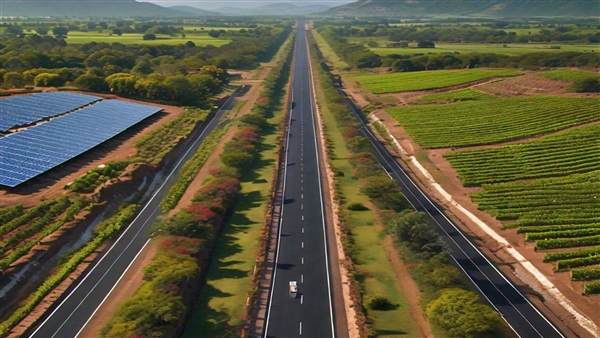The Indian government and the World Bank have joined hands to implement the Green National Highway Corridor Project (GNHCP). This initiative aims to construct eco-friendly and climate-resilient highways across four Indian states: Himachal Pradesh, Rajasthan, Uttar Pradesh, and Andhra Pradesh. The project spans a total length of 781 kilometers and has a significant investment plan, with a total project cost of USD 1,288.24 million, approximately INR 7,662.47 crore. Out of this, the World Bank is providing a loan assistance of USD 500 million.
According to PIB the project is scheduled to be completed by May 2026, with a focus on integrating green technologies and sustainable practices. The highways built under this project will not only be modern and motorable but will also prioritize environmental conservation.

Key Features of the Green National Highway Corridor Project
The Green National Highway Corridor Project stands out due to its emphasis on sustainable and environmentally friendly construction methods. The project includes several innovative practices to minimize environmental impact:
- Conservation of Natural Resources: The construction will utilize cement-treated sub-base and reclaimed asphalt pavement. This approach reduces the need for new materials, conserving natural resources.
- Use of Local and Marginal Materials: The project promotes the use of locally available materials such as lime, fly ash, and waste plastic. This practice not only reduces transportation costs but also encourages the use of materials that are otherwise considered waste, thereby reducing environmental pollution.
- Bio-engineering Measures for Slope Protection: In areas prone to erosion and landslides, the project will employ bio-engineering solutions. These include using coco fiber or jute erosion control blankets combined with shrub and grass plantations. Other techniques involve hydroseeding, using Shotcrete crib walls with vegetation, bamboo plantations, hedge brush layers, and interlink chain mesh with grass strips. The use of Geocell technology combined with hydroseeding will also be explored for slope protection.
These measures are particularly beneficial for hilly regions, where traditional construction methods can lead to significant environmental degradation. By implementing these green technologies, the project aims to reduce carbon emissions and conserve natural resources throughout the highway’s lifecycle, from construction to operation.
| SI No. | Corridor | NH No. | Length in km | State |
|---|---|---|---|---|
| 1 | Koyyuru – Chaprathipalem – Lambasingi – Paderu – Gondiguda – Araku section & Bowdara – Vizianagaram section | 516E | 211 | Andhra Pradesh |
| 2 | Ras – Beawar – Ashind – Mandal Section | 158 | 117 | Rajasthan |
| 3 | Hamirpur – Karnohal – Kalwahn – Mandi section | 70 | 109 | Himachal Pradesh |
| Paonta Sahib – Hewna – Ashyari – Shri Kyari – Gumma-Fediz section | 707 | 104 | Himachal Pradesh | |
| 4 | Bewar – Near Karri Village – Etawah Section | 92 | 57 | Uttar Pradesh |
| Bewar – Allahganj – Miranpur Katra – Radhaita – Pilibhit Section | 730C, 730B & 731K | 183 | Uttar Pradesh | |
| Total | 781 |
Socio-economic Benefits
The Green National Highway Corridor Project is not just about building roads; it aims to foster socio-economic development in the regions it covers. The improved roads will provide all-weather connectivity, making it easier for people to travel and transport goods. This enhanced connectivity will help integrate remote areas with more developed regions, thereby boosting local economies.
The new highways will open up new employment opportunities and promote inclusive growth by connecting people to mainstream areas. This connectivity is expected to lead to increased trade and business activities, further contributing to the prosperity of the regions involved.





